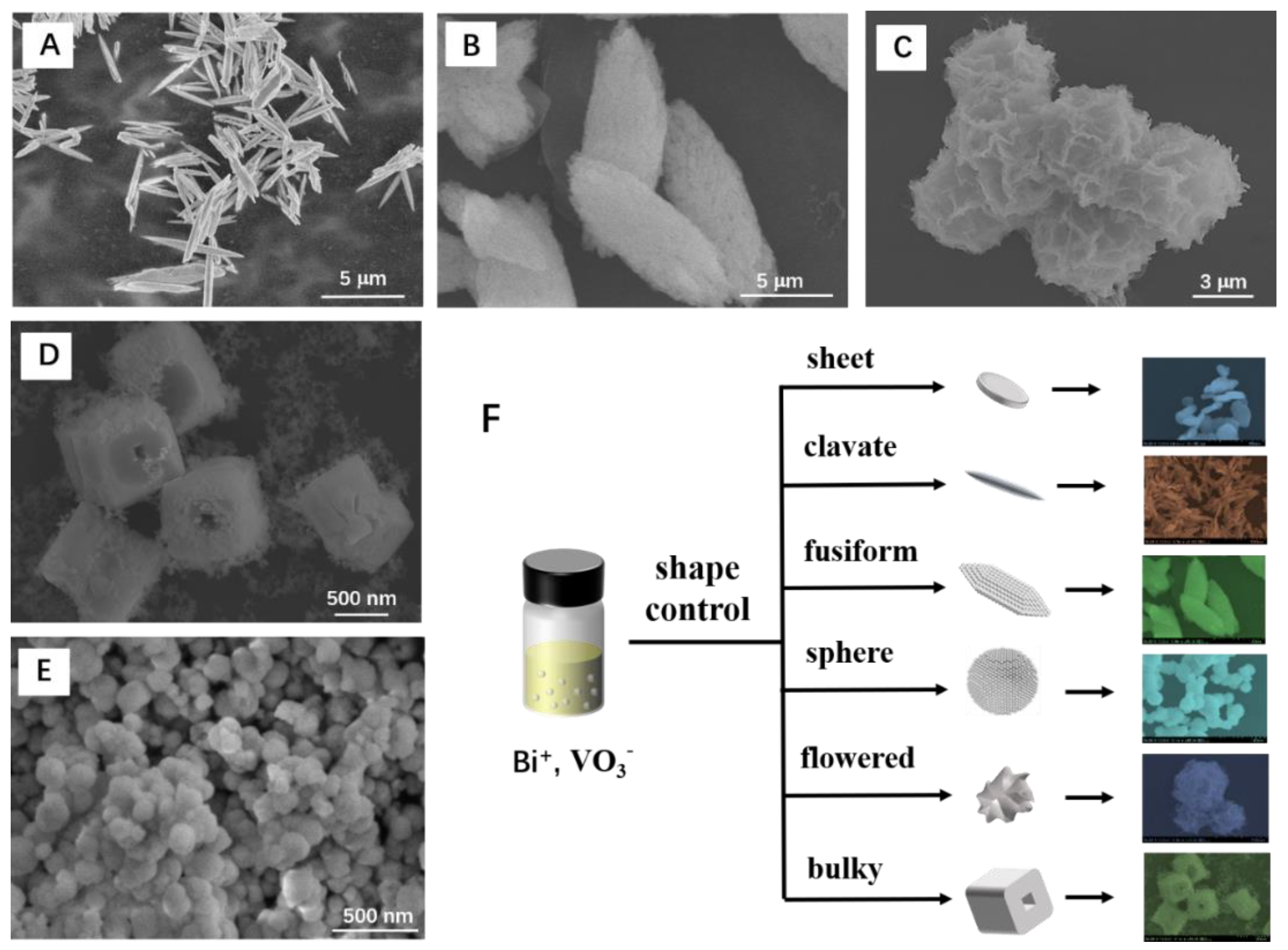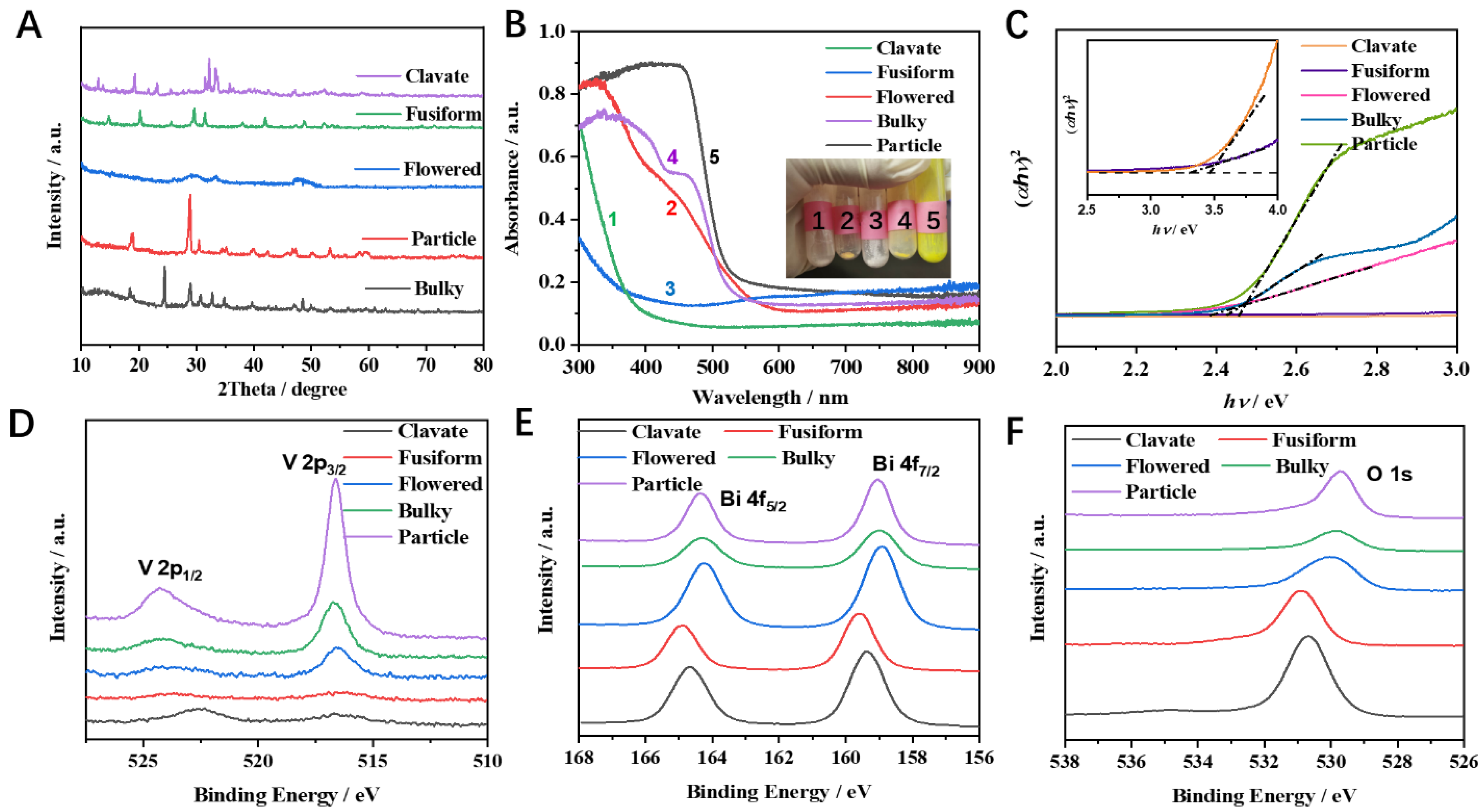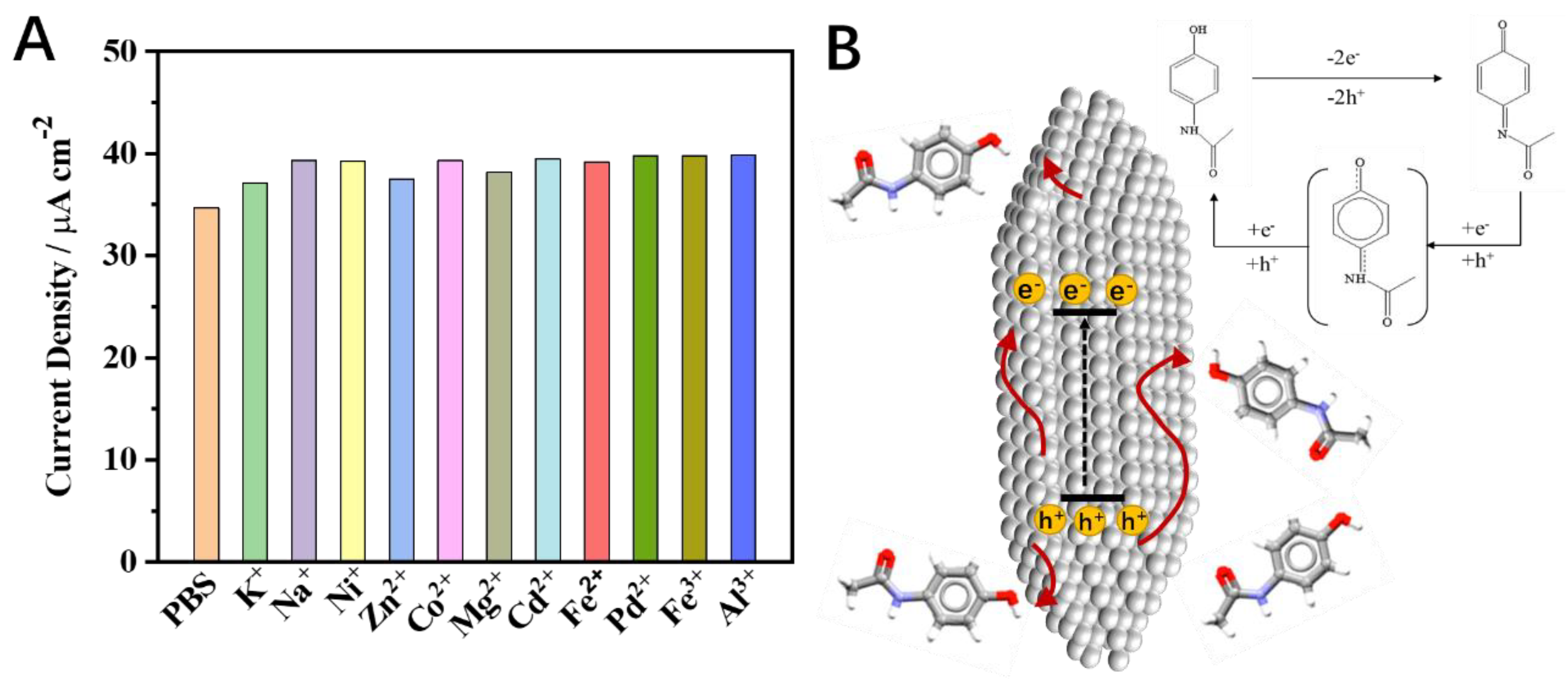Morphology Effect of Bismuth Vanadate on Electrochemical Sensing for the Detection of Paracetamol
Abstract
:1. Introduction
2. Experimental Section
2.1. Apparatus
2.2. Chemicals and Reagents
2.3. Preparation of Bismuth Vanadate
2.4. Determination of Paracetamol in Tablets
3. Results and Discussion
3.1. Characterization of BiVO4 with Different Morphologies
3.2. Optical Analysis of BiVO4 Samples
3.3. Electrochemical Response at Various BiVO4 Electrodes
3.4. Structural Characterization of Clavate BiVO4
3.5. Electrochemical Investigation of Paracetamol on Clavate BiVO4
3.6. Determination of Paracetamol in Pharmaceutical Samples
4. Conclusions
Supplementary Materials
Author Contributions
Funding
Institutional Review Board Statement
Informed Consent Statement
Data Availability Statement
Conflicts of Interest
References
- Alsultan, A.; Peloquin, C.A. Therapeutic drug monitoring in the treatment of tuberculosis: An update. Drugs 2014, 74, 839–854. [Google Scholar] [CrossRef]
- Caldera, F.; Nistic, R.; Magnacca, G.; Matencio, A.; Monfared, K.; Trotta, F. Magnetic composites of dextrin-based carbonate nanosponges and iron oxide nanoparticles with potential application in targeted drug delivery. Nanomaterials 2022, 12, 754. [Google Scholar] [CrossRef]
- Bateman, D.N.; Dear, J.W. Acetylcysteine in paracetamol poisoning: A perspective of 45 years of use. Toxicol. Res. 2019, 8, 489–498. [Google Scholar] [CrossRef] [PubMed]
- McCrae, J.C.; Morrison, E.E.; MacIntyre, I.M.; Dear, J.W.; Webb, D.J. Long-term adverse effects of paracetamol-a review. Br. J. Clin. Pharmacol. 2018, 84, 2218–2230. [Google Scholar] [CrossRef] [Green Version]
- Goscianska, J.; Olejnik, A.; Ejsmont, A.; Galarda, A.; Wuttke, S. Overcoming the paracetamol dose challenge with wrinkled mesoporous carbon spheres. J. Colloid Interf. Sci. 2021, 15, 673–682. [Google Scholar] [CrossRef]
- Wang, X.; Wu, Q.; Liu, A.; Anadón, A.; Rodríguez, J.L.; Martínez-Larrañaga, M.R.; Yuan, Z.; Martínez, M.A. Paracetamol: Overdose-induced oxidative stress toxicity, metabolism, and protective effects of various compounds In Vivo and In Vitro. Drug Metab. Rev. 2017, 49, 395–437. [Google Scholar] [CrossRef] [PubMed]
- Boyd, E.M.; Eastham, W.N. Liver necrosis from paracetamol. Br. Med. J. 1966, 2, 497–499. [Google Scholar] [CrossRef] [PubMed] [Green Version]
- Fan, Y.; Liu, J.H.; Lu, H.T.; Zhang, Q. Electrochemical behavior and voltammetric determination of paracetamol on Nafion/TiO2-graphene modified glassy carbon electrode. Colloids Surf. B 2011, 85, 289–292. [Google Scholar] [CrossRef]
- Deroco, P.B.; Vicentini, F.C.; Fatibello-Filho, O. An electrochemical Sensor for the Simultaneous determination of paracetamol and codeine using a glassy carbon electrode modified with nickel oxide nanoparticles and carbon black. Electroanalysis 2015, 27, 2214–2220. [Google Scholar] [CrossRef]
- Vinay, M.M.; Nayaka, Y.A. Iron oxide (Fe2O3) nanoparticles modified carbon paste electrode as an advanced material for electrochemical investigation of paracetamol and dopamine. J. Sci. Adv. Mater. Dev. 2019, 4, 442–450. [Google Scholar] [CrossRef]
- Wu, Q.; Chen, S.; Guan, L.; Wu, H. Highly sensitive photothermal fiber sensor based on MXene device and vernier effect. Nanomaterials 2022, 12, 766. [Google Scholar] [CrossRef] [PubMed]
- Monsef, R.; Salavati-Niasari, M. Electrochemical sensor based on a chitosan-molybdenum vanadate nanocomposite for detection of hydroxychloroquine in biological samples. J. Colloid Interface Sci. 2022, 613, 1–14. [Google Scholar] [CrossRef]
- Zhao, P.; Ni, M.; Chen, C.; Zhou, Z.; Li, X.; Li, C.; Xie, Y.; Fei, J. Stimuli-enabled switch-like paracetamol electrochemical sensor based on thermosensitive polymer and MWCNTs-GQDs composite nanomaterial. Nanoscale 2019, 11, 7394–7403. [Google Scholar] [CrossRef] [PubMed]
- Kim, J.H.; Lee, J.S. Elaborately modified BiVO4 photoanodes for solar water splitting. Adv. Mater. 2019, 31, 1806938. [Google Scholar] [CrossRef]
- Baral, B.; Reddy, K.H.; Parida, K.M. Construction of M-BiVO4/T-BiVO4 isotype heterojunction for enhanced photocatalytic degradation of norfloxacine and oxygen evolution reaction. J. Colloid Interface Sci. 2019, 554, 278–295. [Google Scholar] [CrossRef] [PubMed]
- Wang, L.; Bian, Z. Photocatalytic degradation of paracetamol on Pd-BiVO4 under visible light irradiation. Chemosphere 2020, 239, 124815. [Google Scholar] [CrossRef]
- Orimolade, B.O.; Zwane, B.N.; Koiki, B.A.; Rivallin, M.; Bechelany, M.; Mabuba, N.; Lesage, G.; Cretin, M.; Arotiba, O.A. Coupling cathodic electro-fenton with anodic photo-electrochemical oxidation: A feasibility study on the mineralization of paracetamol. J. Environ. Chem. Eng. 2020, 8, 104394. [Google Scholar] [CrossRef]
- da Silva Araújo, M.; Barretto, T.R.; Galvão, J.C.R.; Tarley, C.R.T.; Dall’Antônia, L.H.; de Matos, R.; Medeiros, R.A. Visible light photoelectrochemical sensor for acetaminophen determination using a glassy carbon electrode modified with BiVO4 nanoparticles. Electroanalysis 2021, 33, 663–671. [Google Scholar] [CrossRef]
- Zaera, F. Shape-controlled nanostructures in heterogeneous catalysis. ChemSusChem 2013, 6, 1797–1820. [Google Scholar] [CrossRef]
- Joo, J.; Kim, T.; Lee, J.; Choi, S.; Lee, K. Morphology-controlled metal sulfides and phosphides for electrochemical water splitting. Adv. Mater. 2019, 31, 1806682. [Google Scholar] [CrossRef] [PubMed]
- Feng, J.; Li, F.; Liu, L.; Liu, X.; Qian, Y.; Ren, X.; Wang, X.; Qin, W. Ultrasensitive photoelectrochemical immunosensor for procalcitonindetection with porous nanoarray BiVO4/CuxS platform as advanced signalamplification under anodic bias. Sens. Actuators B Chem. 2020, 308, 1276852. [Google Scholar] [CrossRef]
- Santen, R.A.V. Complementary structure sensitive and insensitive catalytic relationships. Acc. Chem. Res. 2009, 42, 57–66. [Google Scholar] [CrossRef] [PubMed]
- Tan, X.; Shen, J.; Semagina, N.; Secanell, M. Decoupling structure-sensitive deactivation mechanisms of Ir/IrOx electrocatalysts toward oxygen evolution reaction. J. Catal. 2019, 371, 57–70. [Google Scholar] [CrossRef]
- Lu, H.; Hao, Q.; Chen, T.; Zhang, L.; Chen, D.; Ma, C.; Yao, W.; Zhu, Y. A high-performance Bi2O3/Bi2SiO5 p-n heterojunction photocatalyst induced by phase transition of Bi2O3. Appl. Catal. B Environ. 2018, 237, 59–67. [Google Scholar] [CrossRef]
- Lopez, R.; Gomez, R. Band-gap energy estimation from diffuse reflectance measurements on sol–gel and commercial TiO2: A comparative study. J. Sol-Gel Sci. Technol. 2012, 61, 1–7. [Google Scholar] [CrossRef]
- Gao, Y.; Li, X.; Hu, J.; Fan, W.; Wang, F.; Xu, D.; Ding, J.; Bai, H.; Shi, W. Ag-Pi/BiVO4 heterojunction with efficient interface carrier transport for photoelectrochemical water splitting. J. Colloid Interface Sci. 2020, 579, 619–627. [Google Scholar] [CrossRef] [PubMed]
- Wong, A.; Santos, A.M.; Fatibello-Filho, O. Simultaneous determination of paracetamol and levofloxacin using a glassy carbon electrode modified with carbon black, silver nanoparticles and PEDOT:PSS film. Sens. Actuators B Chem. 2018, 255, 2264–2273. [Google Scholar] [CrossRef]
- Yang, L.; Zhang, B.; Xu, B.; Zhao, F.; Zeng, B. Ionic liquid functionalized 3D graphene-carbon nanotubes–AuPd nanoparticles–molecularly imprinted copolymer based paracetamol electrochemical sensor: Preparation, characterization and application. Talanta 2021, 224, 121845. [Google Scholar] [CrossRef] [PubMed]
- Atta, N.F.; Galal, A.; Ahmed, Y.M.; El-Ads, E.H. Design strategy and preparation of a conductive layered electrochemical sensor for simultaneous determination of ascorbic acid, dobutamine, acetaminophen and amlodipine. Sens. Actuators B Chem. 2019, 297, 126648. [Google Scholar] [CrossRef]
- Miner, D.J.; Rice, J.R.; Riggin, R.M.; Kissinger, P.T. Voltammetry of acetaminophen and its metabolites. Anal. Chem. 1981, 53, 2258–2263. [Google Scholar] [CrossRef]
- Augustyn, V.; Simon, P.; Dunn, B. Pseudocapacitive oxide materials for high-rate electrochemical energy storage. Energy Environ. Sci. 2014, 7, 1597–1614. [Google Scholar] [CrossRef] [Green Version]
- Li, P.; Chen, X.; He, H.; Zhou, X.; Zhou, Y.; Zou, Z. Polyhedral 30-faceted BiVO4 microcrystals predominantly enclosed by high-index planes promoting photocatalytic water-splitting activity. Adv. Mater. 2018, 30, 170311. [Google Scholar] [CrossRef] [PubMed]
- Liu, X.; Chen, W.; Wang, W.; Jiang, Y.; Cao, K.; Jiao, Z. F-regulate the preparation of polyhedral BiVO4 enclosed by high-Index facet and enhance its photocatalytic activity. J. Colloid Interface Sci. 2022, 606, 393–405. [Google Scholar] [CrossRef] [PubMed]
- Kang, X.; Wang, J.; Wu, H.; Liu, J.; Aksay, I.A.; Lin, Y. A graphene-based electrochemical sensor for sensitive detection of paracetamol. Talanta 2010, 3, 754–759. [Google Scholar] [CrossRef]
- Atta, N.F.; Azab, A.G.M. Electrochemical determination of paracetamol using gold nanoparticles-application in tablets and human fluids. Int. J. Electrochem. Sci. 2011, 6, 5082–5096. [Google Scholar]
- Li, M.; Wang, W.; Chen, Z.; Song, Z.; Luo, X. Electrochemical determination of paracetamol based on Au@graphene core-shell nanoparticles doped conducting polymer PEDOT nanocomposite. Sens. Actuat. B-Chem. 2018, 260, 778–785. [Google Scholar] [CrossRef]
- Kutluay, A.; Aslanoglu, M. An electrochemical sensor prepared by sonochemical one-pot synthesis of multi-walled carbon nanotube-supported cobalt nanoparticles for the simultaneous determination of paracetamol and dopamine. Anal. Chim. Acta 2014, 839, 59–66. [Google Scholar] [CrossRef]
- Li, J.; Liu, J.; Tan, G.; Jiang, J.; Peng, S.; Deng, M.; Qian, D.; Feng, Y.; Liu, Y. High-sensitivity paracetamol sensor based on Pd/graphene oxide nanocomposite as an enhanced electrochemical sensing platform. Biosens. Bioelectron. 2014, 54, 468–475. [Google Scholar] [CrossRef]
- Luo, J.; Fan, C.; Wang, X.; Liu, R.; Liu, X. A novel electrochemical sensor for paracetamol based on molecularly imprinted polymeric micelles. Sens. Actuat. B-Chem 2013, 188, 909–916. [Google Scholar] [CrossRef]
- Bonyadi, S.; Ghanbari, K.; Ghiasi, M. All-electrochemical synthesis of a three-dimensional mesoporous polymeric g-C3N4/PANI/CdO nanocomposite and its application as a novel sensor for the simultaneous determination of epinephrine, paracetamol, mefenamic acid, and ciprofloxacin. New J. Chem. 2020, 44, 3412. [Google Scholar] [CrossRef]
- Wei, R. Biosynthesis of Au–Ag alloy nanoparticles for sensitive electrochemical determination of paracetamol. Int. J. Electrochem. Sci. 2017, 12, 9131–9140. [Google Scholar] [CrossRef]
- Asadpour-Zeynali, K.; Amini, R. Nanostructured hexacyanoferrate intercalated Ni/Al layered double hydroxide modified electrode as a sensitive electrochemical sensor for paracetamol determination. Electroanalysis 2017, 29, 635–642. [Google Scholar] [CrossRef]
- Kumar, Y.; Pramanik, P.; Das, D.K. Electrochemical detection of paracetamol and dopamine molecules using nano-particles of cobalt ferrite and manganese ferrite modified with graphite. Heliyon 2019, 5, e02031. [Google Scholar] [CrossRef] [Green Version]
- Matt, S.B.; Raghavendra, S.; Shivanna, M.; Sidlinganahalli, M.; Siddalingappa, D.M. Electrochemical detection of paracetamol by voltammetry techniques using pure zirconium oxide nanoparticle based modified carbon paste electrode. J. Inorg. Organomet. Polym. Mater. 2021, 31, 511–519. [Google Scholar] [CrossRef]
- Zidan, M.; Tee, T.W.; Abdullah, A.H.; Zainal, Z.; Kheng, G.J. Electrochemical oxidation of paracetamol mediated by nanoparticles bismuth oxide modified glassy carbon Electrode. Int. J. Electrochem. Sci. 2011, 6, 279–288. [Google Scholar]






| Shape | Structure | Size | Color | Band Gap | Impurity |
|---|---|---|---|---|---|
| clavate | tetragonal | L = 5 µm W = 400 nm | white | 3.45 eV | bismuth oxide |
| fusiform | orthorhombic | L = 5–10 µm W = 2–4 µm | off-white | 3.30 eV | bismuth oxide |
| flowered | tetragonal | D = 5 µm | light-yellow | 2.38 eV | None |
| bulky | tetragonal | D = 600 nm | yellow | 2.40 eV | None |
| particle | tetragonal | D = 100–200 nm | yellow | 2.45 eV | None |
| Sample | No. | Calculated/µM | Found by HPLC/µM | Found by DPV/µM | Recovery/% |
|---|---|---|---|---|---|
| Paracetamol tablets (Ⅱ) | 1 | 45.0 | 41.4 | 42.2 | 101.9 |
| 2 | 45.0 | 40.9 | 39.6 | 96.8 | |
| 3 | 45.0 | 40.8 | 39.2 | 96.1 |
Publisher’s Note: MDPI stays neutral with regard to jurisdictional claims in published maps and institutional affiliations. |
© 2022 by the authors. Licensee MDPI, Basel, Switzerland. This article is an open access article distributed under the terms and conditions of the Creative Commons Attribution (CC BY) license (https://creativecommons.org/licenses/by/4.0/).
Share and Cite
Liu, Y.; Xu, X.; Ma, C.; Zhao, F.; Chen, K. Morphology Effect of Bismuth Vanadate on Electrochemical Sensing for the Detection of Paracetamol. Nanomaterials 2022, 12, 1173. https://doi.org/10.3390/nano12071173
Liu Y, Xu X, Ma C, Zhao F, Chen K. Morphology Effect of Bismuth Vanadate on Electrochemical Sensing for the Detection of Paracetamol. Nanomaterials. 2022; 12(7):1173. https://doi.org/10.3390/nano12071173
Chicago/Turabian StyleLiu, Ying, Xiaocui Xu, Churong Ma, Feng Zhao, and Kai Chen. 2022. "Morphology Effect of Bismuth Vanadate on Electrochemical Sensing for the Detection of Paracetamol" Nanomaterials 12, no. 7: 1173. https://doi.org/10.3390/nano12071173
APA StyleLiu, Y., Xu, X., Ma, C., Zhao, F., & Chen, K. (2022). Morphology Effect of Bismuth Vanadate on Electrochemical Sensing for the Detection of Paracetamol. Nanomaterials, 12(7), 1173. https://doi.org/10.3390/nano12071173







